

Compact Muon Solenoid
LHC, CERN
| CMS-EXO-20-006 ; CERN-EP-2023-115 | ||
| Search for Z' bosons decaying to pairs of heavy Majorana neutrinos in proton-proton collisions at √s= 13 TeV | ||
| CMS Collaboration | ||
| 13 July 2023 | ||
| JHEP 11 (2023) 181 | ||
| Abstract: A search for the production of pairs of heavy Majorana neutrinos (N) from the decays of Z' bosons is performed using the CMS detector at the LHC. The data were collected in proton-proton collisions at a center-of-mass energy of √s= 13 TeV, with an integrated luminosity of 138 fb−1. The signature for the search is an excess in the invariant mass distribution of the final-state objects, two same-flavor leptons (e or μ) and at least two jets. No significant excess of events beyond the expected background is observed. Upper limits at 95% confidence level are set on the product of the Z' production cross section and its branching fraction to a pair of N, as functions of N and Z' boson masses (mN and mZ′, respectively) for mZ′ from 0.4 to 4.6 TeV and mN from 0.1 TeV to mZ′/ 2. In the theoretical framework of a left-right symmetric model, exclusion bounds in the mN−mZ′ plane are presented in both the electron and muon channels. The observed upper limit on mZ′ reaches up to 4.42 TeV. These are the most restrictive limits to date on the mass of N as a function of the Z' boson mass. | ||
| Links: e-print arXiv:2307.06959 [hep-ex] (PDF) ; CDS record ; inSPIRE record ; HepData record ; CADI line (restricted) ; | ||
| Figures | |

png pdf |
Figure 1:
Feynman diagram representing the pair production of N via Z' boson exchange, where ℓ= e or μ. Each N decays into a lepton and two quarks, and we assume that the W±R is heavier than the N. Both opposite- and same-sign dileptons from the decays of the heavy neutrino pair are allowed, because of the Majorana nature of N. |
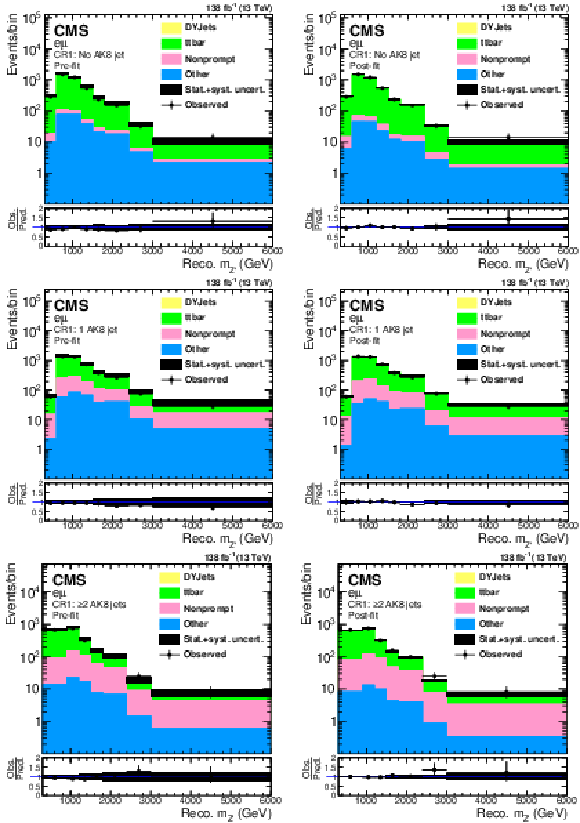
png pdf |
Figure 2:
Reconstructed mass of the Z' candidate in CR1 (eμ), which consists of flavor sidebands of SR1 (upper), SR2 (middle), and SR3 (lower) regions. Pre-fit (post-fit) results are shown on the left (right). The fitting procedure is described in Section 7. The contribution from DY events is too small to be visible on these plots. The lower panel of each plot shows the ratio of observed events to expected background. |

png pdf |
Figure 2-a:
Reconstructed mass of the Z' candidate in CR1 (eμ), which consists of flavor sidebands of the SR1 region (no AK8 jet). Pre-fit results are shown. The fitting procedure is described in Section 7. The contribution from DY events is too small to be visible. The lower panel shows the ratio of observed events to expected background. |
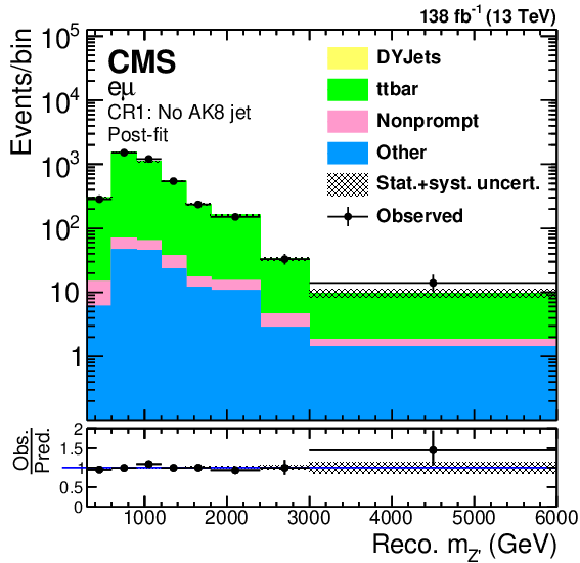
png pdf |
Figure 2-b:
Reconstructed mass of the Z' candidate in CR1 (eμ), which consists of flavor sidebands of the SR1 region (no AK8 jet). Post-fit results are shown. The fitting procedure is described in Section 7. The contribution from DY events is too small to be visible. The lower panel shows the ratio of observed events to expected background. |

png pdf |
Figure 2-c:
Reconstructed mass of the Z' candidate in CR1 (eμ), which consists of flavor sidebands of the SR2 region (1 AK8 jet). Pre-fit results are shown. The fitting procedure is described in Section 7. The contribution from DY events is too small to be visible. The lower panel shows the ratio of observed events to expected background. |

png pdf |
Figure 2-d:
Reconstructed mass of the Z' candidate in CR1 (eμ), which consists of flavor sidebands of the SR2 region (1 AK8 jet). Post-fit results are shown. The fitting procedure is described in Section 7. The contribution from DY events is too small to be visible. The lower panel shows the ratio of observed events to expected background. |
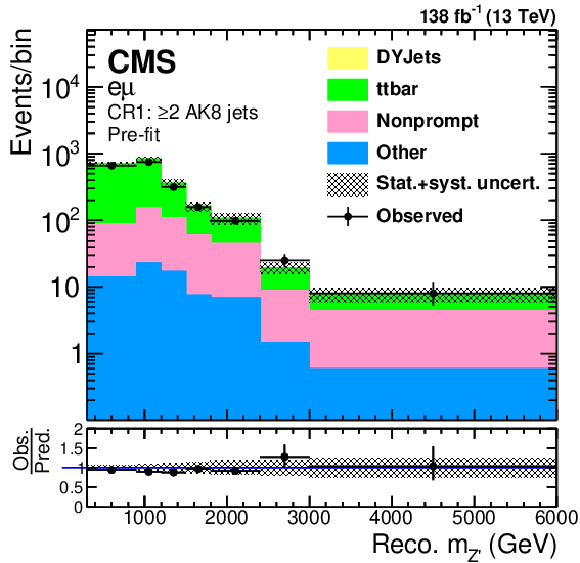
png pdf |
Figure 2-e:
Reconstructed mass of the Z' candidate in CR1 (eμ), which consists of flavor sidebands of the SR3 region (≥2 AK8 jet). Pre-fit results are shown. The fitting procedure is described in Section 7. The contribution from DY events is too small to be visible. The lower panel shows the ratio of observed events to expected background. |

png pdf |
Figure 2-f:
Reconstructed mass of the Z' candidate in CR1 (eμ), which consists of flavor sidebands of SR1 (upper), SR2 (middle), and SR3 (lower) regions. Pre-fit (post-fit) results are shown on the left (right). The fitting procedure is described in Section 7. The contribution from DY events is too small to be visible on these plots. The lower panel of each plot shows the ratio of observed events to expected background. |
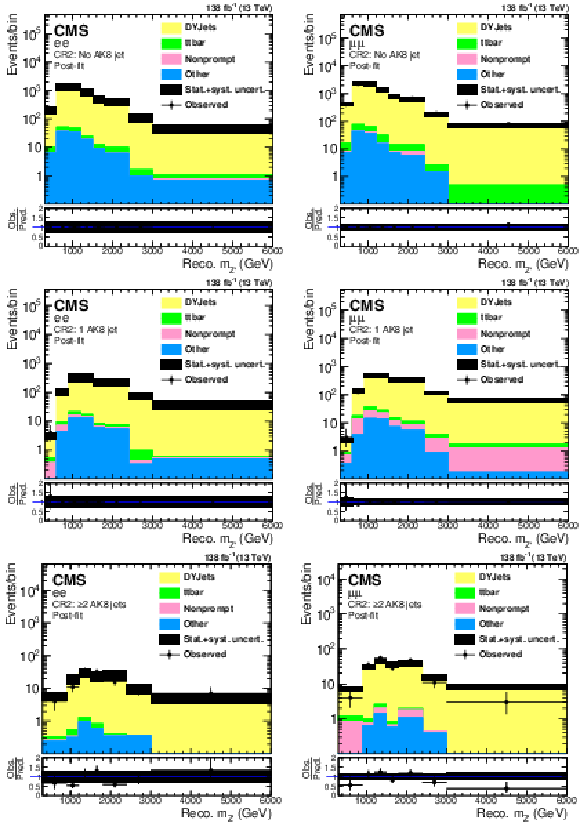
png pdf |
Figure 3:
Reconstructed mass of the Z' candidate in CR2 (ee and μμ), which consists of the dilepton mass sidebands of SR1 (upper), SR2 (middle), and SR3 (lower) regions. Post-fit dielectron (dimuon) channel results are shown on the left (right). The fitting procedure is described in Section 7. The lower panel of each plot shows the ratio of observed events to expected background. |
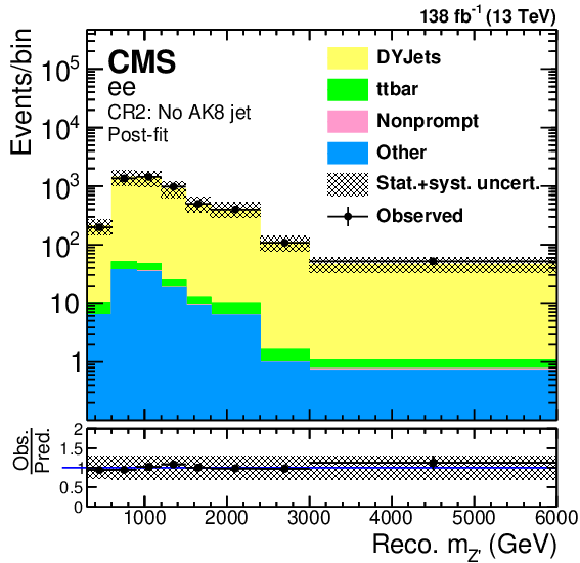
png pdf |
Figure 3-a:
Reconstructed mass of the Z' candidate in CR2 (ee and μμ), which consists of the dilepton mass sidebands of SR1 (no AK8 jet). Post-fit dielectron channel results are shown. The fitting procedure is described in Section 7. The lower panel shows the ratio of observed events to expected background. |
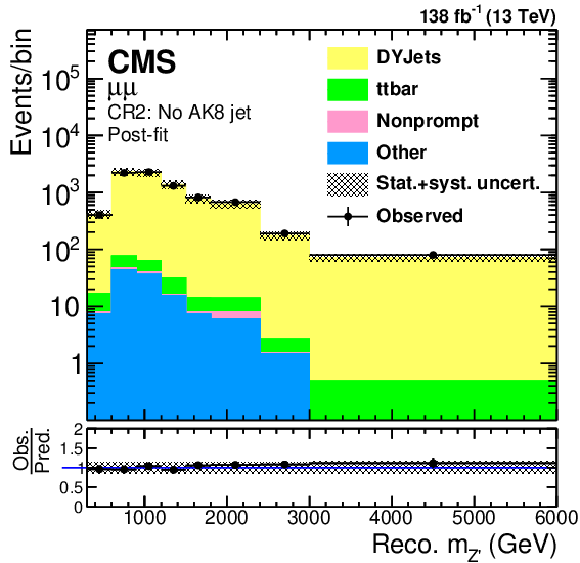
png pdf |
Figure 3-b:
Reconstructed mass of the Z' candidate in CR2 (ee and μμ), which consists of the dilepton mass sidebands of SR1 (no AK8 jet). Post-fit dimuon channel results are shown. The fitting procedure is described in Section 7. The lower panel shows the ratio of observed events to expected background. |

png pdf |
Figure 3-c:
Reconstructed mass of the Z' candidate in CR2 (ee and μμ), which consists of the dilepton mass sidebands of SR2 (1 AK8 jet). Post-fit dielectron channel results are shown. The fitting procedure is described in Section 7. The lower panel shows the ratio of observed events to expected background. |
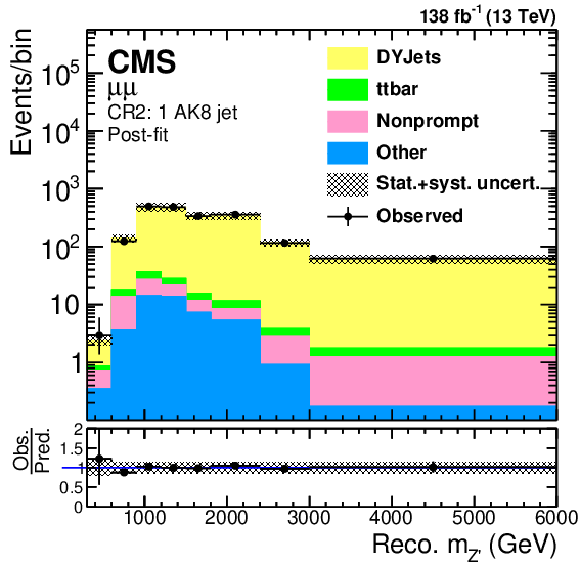
png pdf |
Figure 3-d:
Reconstructed mass of the Z' candidate in CR2 (ee and μμ), which consists of the dilepton mass sidebands of SR2 (1 AK8 jet). Post-fit dimuon channel results are shown. The fitting procedure is described in Section 7. The lower panel shows the ratio of observed events to expected background. |

png pdf |
Figure 3-e:
Reconstructed mass of the Z' candidate in CR2 (ee and μμ), which consists of the dilepton mass sidebands of SR3 (≥2 AK8 jet). Post-fit dielectron channel results are shown. The fitting procedure is described in Section 7. The lower panel shows the ratio of observed events to expected background. |
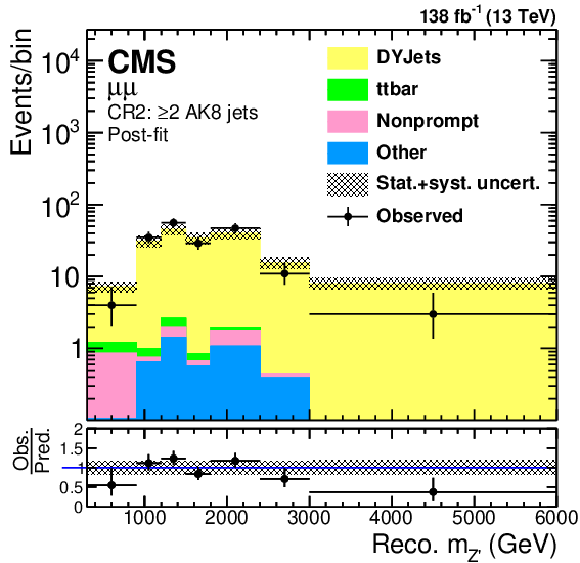
png pdf |
Figure 3-f:
Reconstructed mass of the Z' candidate in CR2 (ee and μμ), which consists of the dilepton mass sidebands of SR4 (≥2 AK8 jet). Post-fit dimuon channel results are shown. The fitting procedure is described in Section 7. The lower panel shows the ratio of observed events to expected background. |

png pdf |
Figure 4:
Distributions of the reconstructed Z' candidate mass in SR1 (upper row), SR2 (middle row) and SR3 (lower row). The left (right) column corresponds to the dielectron (dimuon) channel. Signal samples with (mZ′,mN)= (1000, 100) GeV, (1000, 300) GeV, (4000, 200) GeV, and (4000, 1200) GeV are shown together with a reference cross section times branching fraction of 1 fb. The lower panel of each plot shows the ratio of observed events to expected background. |

png pdf |
Figure 4-a:
Distributions of the reconstructed Z' candidate mass in SR1 (no AK8 jet), for the dielectron channel. Signal samples with (mZ′,mN)= (1000, 100) GeV, (1000, 300) GeV, (4000, 200) GeV, and (4000, 1200) GeV are shown together with a reference cross section times branching fraction of 1 fb. The lower panel shows the ratio of observed events to expected background. |
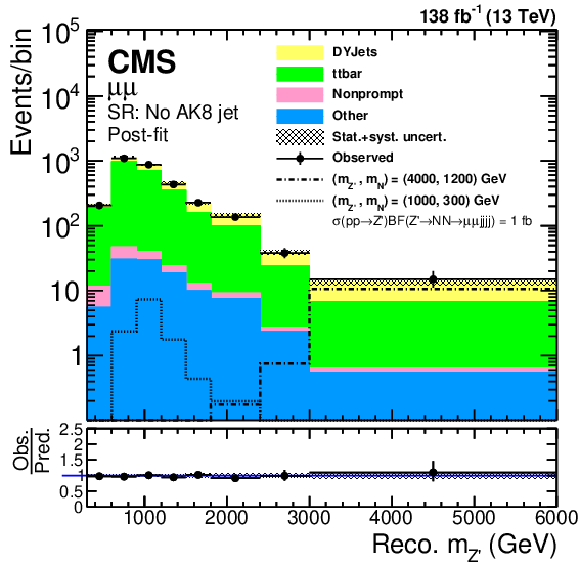
png pdf |
Figure 4-b:
Distributions of the reconstructed Z' candidate mass in SR1 (no AK8 jet), for the dimuon channel. Signal samples with (mZ′,mN)= (1000, 100) GeV, (1000, 300) GeV, (4000, 200) GeV, and (4000, 1200) GeV are shown together with a reference cross section times branching fraction of 1 fb. The lower panel shows the ratio of observed events to expected background. |

png pdf |
Figure 4-c:
Distributions of the reconstructed Z' candidate mass in SR2 (1 AK8 jet), for the dielectron channel. Signal samples with (mZ′,mN)= (1000, 100) GeV, (1000, 300) GeV, (4000, 200) GeV, and (4000, 1200) GeV are shown together with a reference cross section times branching fraction of 1 fb. The lower panel shows the ratio of observed events to expected background. |
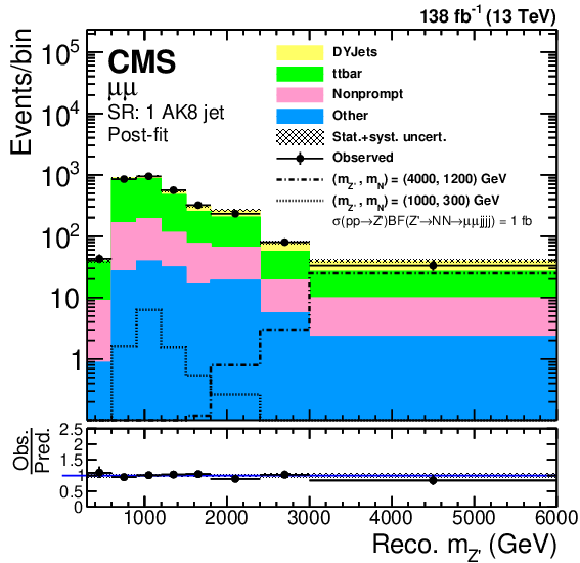
png pdf |
Figure 4-d:
Distributions of the reconstructed Z' candidate mass in SR2 (1 AK8 jet), for the dimuon channel. Signal samples with (mZ′,mN)= (1000, 100) GeV, (1000, 300) GeV, (4000, 200) GeV, and (4000, 1200) GeV are shown together with a reference cross section times branching fraction of 1 fb. The lower panel shows the ratio of observed events to expected background. |

png pdf |
Figure 4-e:
Distributions of the reconstructed Z' candidate mass in SR3 (≥2 AK8 jet), for the dielectron channel. Signal samples with (mZ′,mN)= (1000, 100) GeV, (1000, 300) GeV, (4000, 200) GeV, and (4000, 1200) GeV are shown together with a reference cross section times branching fraction of 1 fb. The lower panel shows the ratio of observed events to expected background. |

png pdf |
Figure 4-f:
Distributions of the reconstructed Z' candidate mass in SR4 (≥2 AK8 jet), for the dimuon channel. Signal samples with (mZ′,mN)= (1000, 100) GeV, (1000, 300) GeV, (4000, 200) GeV, and (4000, 1200) GeV are shown together with a reference cross section times branching fraction of 1 fb. The lower panel shows the ratio of observed events to expected background. |
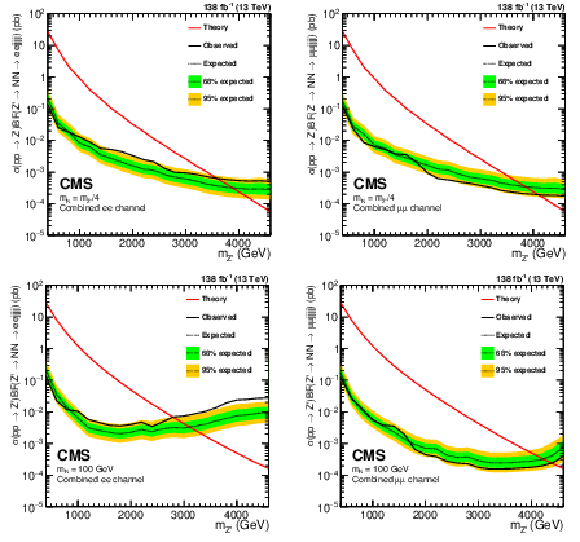
png pdf |
Figure 5:
The observed and expected 95% CL upper limits on the product of Z' boson cross section and branching fraction are shown for the case of mN=mZ′/4 (upper row) and mN= 100 GeV (lower row) for dielectron (left column) and dimuon (right column) channels. The green and yellow bands indicate the 68% and 95% CL regions around the expected limit. The red lines represent values coming from the benchmark LRSM model [45]. Both opposite- and same-sign dileptons from decays of heavy neutrino pairs are considered. |

png pdf |
Figure 5-a:
The observed and expected 95% CL upper limits on the product of Z' boson cross section and branching fraction are shown for the case of mN=mZ′/4 for the dielectron channel. The green and yellow bands indicate the 68% and 95% CL regions around the expected limit. The red lines represent values coming from the benchmark LRSM model [45]. Both opposite- and same-sign dileptons from decays of heavy neutrino pairs are considered. |

png pdf |
Figure 5-b:
The observed and expected 95% CL upper limits on the product of Z' boson cross section and branching fraction are shown for the case of mN=mZ′/4 for the dimuon channel. The green and yellow bands indicate the 68% and 95% CL regions around the expected limit. The red lines represent values coming from the benchmark LRSM model [45]. Both opposite- and same-sign dileptons from decays of heavy neutrino pairs are considered. |
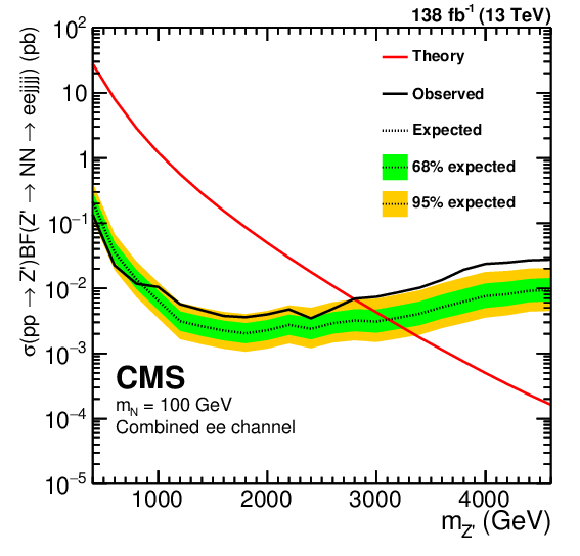
png pdf |
Figure 5-c:
The observed and expected 95% CL upper limits on the product of Z' boson cross section and branching fraction are shown for the case of mN= 100 GeV for the dielectron channel. The green and yellow bands indicate the 68% and 95% CL regions around the expected limit. The red lines represent values coming from the benchmark LRSM model [45]. Both opposite- and same-sign dileptons from decays of heavy neutrino pairs are considered. |
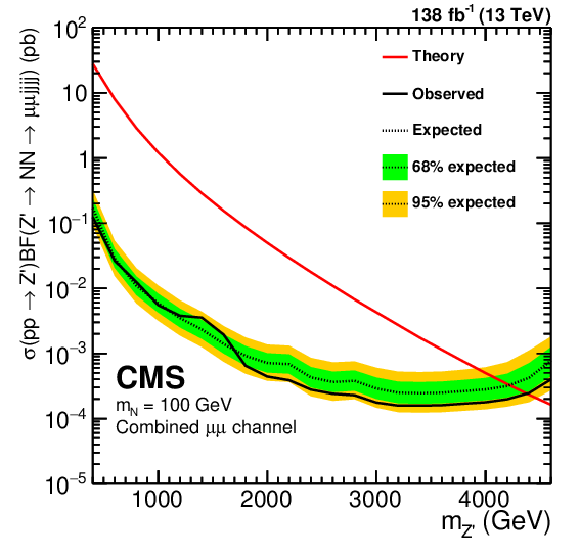
png pdf |
Figure 5-d:
The observed and expected 95% CL upper limits on the product of Z' boson cross section and branching fraction are shown for the case of mN= 100 GeV for the dimuon channel. The green and yellow bands indicate the 68% and 95% CL regions around the expected limit. The red lines represent values coming from the benchmark LRSM model [45]. Both opposite- and same-sign dileptons from decays of heavy neutrino pairs are considered. |
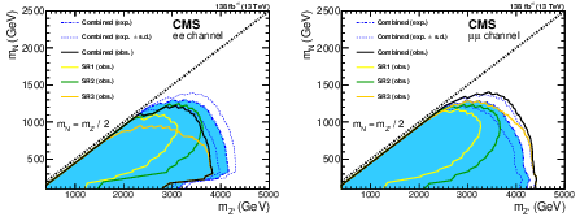
png pdf |
Figure 6:
Observed and expected exclusion regions at 95% CL in the 2D phase space of mZ′ vs. mN for dielectron (left) and dimuon (right) channels. One standard deviation (s.d.) limits are also shown. Both opposite- and same-sign (OS and SS) dileptons from decays of heavy neutrino pairs are considered. |

png pdf |
Figure 6-a:
Observed and expected exclusion regions at 95% CL in the 2D phase space of mZ′ vs. mN for the dielectron channel. One standard deviation (s.d.) limits are also shown. Both opposite- and same-sign (OS and SS) dileptons from decays of heavy neutrino pairs are considered. |

png pdf |
Figure 6-b:
Observed and expected exclusion regions at 95% CL in the 2D phase space of mZ′ vs. mN for the dimuon channel. One standard deviation (s.d.) limits are also shown. Both opposite- and same-sign (OS and SS) dileptons from decays of heavy neutrino pairs are considered. |
| Tables | |

png pdf |
Table 1:
Multiplicity requirements for AK8 jets, tight leptons and AK4 jets in the different signal regions considered in the search. |
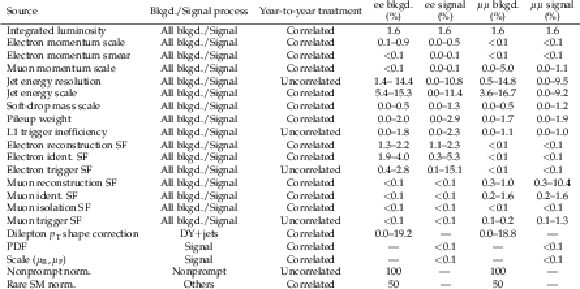
png pdf |
Table 2:
Systematic uncertainties and their impacts on the total number of events in the signal regions. |
| Summary |
| A search for the pair production of heavy Majorana neutrinos (N) via the decay of a Z' boson, in a final state with two same-flavor leptons and at least two reconstructed jets has been performed in proton-proton collisions at a center-of-mass energy of 13 TeV, using LHC 2016--2018 data corresponding to an integrated luminosity of 138 fb−1. No significant excess of events beyond the expected background is observed. Upper limits on the product of signal cross section and branching fraction in the context of a left-right symmetry model scenario are set [45]. Exclusion regions in the dielectron and dimuon channels are set at 95% confidence level. These are the first results of a search for this process at 13 TeV and are the most restrictive limits to date on the mass of N as a function of the Z' boson mass. |
| References | ||||
| 1 | Particle Data Group, R. L. Workman et al. | Review of particle physics | Chapter 14 and references therein, Prog. Theor. Exp. Phys. 2022 (2022) 083C01 |
|
| 2 | SNO Collaboration | Direct evidence for neutrino flavor transformation from neutral current interactions in the Sudbury Neutrino Observatory | PRL 89 (2002) 011301 | nucl-ex/0204008 |
| 3 | Super-Kamiokande Collaboration | Evidence for oscillation of atmospheric neutrinos | PRL 81 (1998) 1562 | hep-ex/9807003 |
| 4 | Super-Kamiokande Collaboration | Evidence for an oscillatory signature in atmospheric neutrino oscillation | PRL 93 (2004) 101801 | hep-ex/0404034 |
| 5 | E. Di Valentino, S. Gariazzo, and O. Mena | Most constraining cosmological neutrino mass bounds | PRD 104 (2021) 083504 | 2106.15267 |
| 6 | KATRIN Collaboration | Direct neutrino-mass measurement with sub-electronvolt sensitivity | Nature Phys. 18 (2022) 160 | 2105.08533 |
| 7 | A. Maiezza, M. Nemevsek, F. Nesti, and G. Senjanović | Left-right symmetry at LHC | PRD 82 (2010) 055022 | 1005.5160 |
| 8 | P. Minkowski | μ→eγ at a rate of one out of 1-billion muon decays? | PLB 67 (1977) 421 | |
| 9 | M. Gell-Mann, P. Ramond, and R. Slansky | Complex spinors and unified theories | in Proc. Supergravity Workshop at Stony Brook, North-Holland, 1979 link |
|
| 10 | T. Yanagida | Horizontal gauge symmetry and masses of neutrinos | in Proc. Workshop on the Unified Theory and the Baryon Number in the Universe, KEK, 1979 | |
| 11 | R. N. Mohapatra and G. Senjanović | Neutrino mass and spontaneous parity nonconservation | PRL 44 (1980) 912 | |
| 12 | M. Doi et al. | CP violation in Majorana neutrinos | PLB 102 (1981) 323 | |
| 13 | CMS Collaboration | Search for resonant and nonresonant new phenomena in high-mass dilepton final states at √s= 13 TeV | JHEP 07 (2021) 208 | CMS-EXO-19-019 2103.02708 |
| 14 | CMS Collaboration | Search for new physics in the lepton plus missing transverse momentum final state in proton-proton collisions at √s= 13 TeV | JHEP 07 (2022) 067 | CMS-EXO-19-017 2202.06075 |
| 15 | CMS Collaboration | Search for heavy majorana neutrinos in same-sign dilepton channels in proton-proton collisions at √s= 13 TeV | JHEP 01 (2019) 122 | CMS-EXO-17-028 1806.10905 |
| 16 | CMS Collaboration | Search for heavy neutral leptons in events with three charged leptons in proton-proton collisions at √s= 13 TeV | PRL 120 (2018) 221801 | CMS-EXO-17-012 1802.02965 |
| 17 | CMS Collaboration | Search for long-lived heavy neutral leptons with displaced vertices in proton-proton collisions at √s= 13 TeV | JHEP 07 (2022) 081 | CMS-EXO-20-009 2201.05578 |
| 18 | ATLAS Collaboration | Search for heavy neutrinos and right-handed W bosons in events with two leptons and jets in pp collisions at √s= 7 TeV with the ATLAS detector | EPJC 72 (2012) 2056 | 1203.5420 |
| 19 | CMS Collaboration | Search for heavy neutrinos and WR bosons with right-handed couplings in a left-right symmetric model in pp collisions at √s= 7 TeV | PRL 109 (2012) 261802 | CMS-EXO-11-091 1210.2402 |
| 20 | CMS Collaboration | Search for heavy neutrinos and W bosons with right-handed couplings in proton-proton collisions at √s= 8 TeV | EPJC 74 (2014) 3149 | CMS-EXO-13-008 1407.3683 |
| 21 | ATLAS Collaboration | Search for heavy majorana neutrinos with the ATLAS detector in pp collisions at √s= 8 TeV | JHEP 07 (2015) 162 | 1506.06020 |
| 22 | CMS Collaboration | Search for heavy neutrinos or third-generation leptoquarks in final states with two hadronically decaying τ leptons and two jets in proton-proton collisions at √s= 13 TeV | JHEP 03 (2017) 077 | CMS-EXO-16-016 1612.01190 |
| 23 | CMS Collaboration | Search for third-generation scalar leptoquarks and heavy right-handed neutrinos in final states with two tau leptons and two jets in proton-proton collisions at √s= 13 TeV | JHEP 07 (2017) 121 | CMS-EXO-16-023 1703.03995 |
| 24 | CMS Collaboration | Search for a heavy right-handed W boson and a heavy neutrino in events with two same-flavor leptons and two jets at √s= 13 TeV | JHEP 05 (2018) 148 | CMS-EXO-17-011 1803.11116 |
| 25 | ATLAS Collaboration | Search for heavy Majorana or Dirac neutrinos and right-handed W gauge bosons in final states with two charged leptons and two jets at √s= 13 TeV with the ATLAS detector | JHEP 01 (2019) 016 | 1809.11105 |
| 26 | ATLAS Collaboration | Search for a right-handed gauge boson decaying into a high-momentum heavy neutrino and a charged lepton in pp collisions with the ATLAS detector at √s= 13 TeV | PLB 798 (2019) 134942 | 1904.12679 |
| 27 | CMS Collaboration | Search for a right-handed W boson and a heavy neutrino in proton-proton collisions at √s= 13 TeV | JHEP 04 (2022) 047 | CMS-EXO-20-002 2112.03949 |
| 28 | ATLAS Collaboration | Search for heavy majorana or dirac neutrinos and right-handed W gauge bosons in final states with charged leptons and jets in pp collisions at √s= 13 TeV with the ATLAS detector | Submitted to EPJC, 2023 | 2304.09553 |
| 29 | CMS Collaboration | HEPData record for this analysis | link | |
| 30 | CMS Collaboration | The CMS experiment at the CERN LHC | JINST 3 (2008) S08004 | |
| 31 | J. Alwall et al. | The automated computation of tree-level and next-to-leading order differential cross sections, and their matching to parton shower simulations | JHEP 07 (2014) 079 | 1405.0301 |
| 32 | J. Alwall et al. | Comparative study of various algorithms for the merging of parton showers and matrix elements in hadronic collisions | EPJC 53 (2008) 473 | 0706.2569 |
| 33 | P. Nason | A new method for combining NLO QCD with shower Monte Carlo algorithms | JHEP 11 (2004) 040 | hep-ph/0409146 |
| 34 | S. Frixione, P. Nason, and C. Oleari | Matching NLO QCD computations with parton shower simulations: the POWHEG method | JHEP 11 (2007) 070 | 0709.2092 |
| 35 | S. Alioli, P. Nason, C. Oleari, and E. Re | A general framework for implementing NLO calculations in shower Monte Carlo programs: the POWHEG BOX | JHEP 06 (2010) 043 | 1002.2581 |
| 36 | S. Frixione, P. Nason, and G. Ridolfi | A positive-weight next-to-leading-order Monte Carlo for heavy flavour hadroproduction | JHEP 09 (2007) 126 | 0707.3088 |
| 37 | T. Sjöstrand et al. | An introduction to PYTHIA 8.2 | Comput. Phys. Commun. 191 (2015) 159 | 1410.3012 |
| 38 | S. Alioli, P. Nason, C. Oleari, and E. Re | NLO single-top production matched with shower in POWHEG: s- and t-channel contributions | JHEP 09 (2009) 111 | 0907.4076 |
| 39 | E. Re | Single-top Wt-channel production matched with parton showers using the POWHEG method | EPJC 71 (2011) 1547 | 1009.2450 |
| 40 | NNPDF Collaboration | Parton distributions for the LHC Run II | JHEP 04 (2015) 040 | 1410.8849 |
| 41 | NNPDF Collaboration | Parton distributions from high-precision collider data | EPJC 77 (2017) 663 | 1706.00428 |
| 42 | CMS Collaboration | Event generator tunes obtained from underlying event and multiparton scattering measurements | EPJC 76 (2016) 155 | CMS-GEN-14-001 1512.00815 |
| 43 | CMS Collaboration | Extraction and validation of a new set of CMS PYTHIA8 tunes from underlying-event measurements | EPJC 80 (2020) 4 | CMS-GEN-17-001 1903.12179 |
| 44 | GEANT4 Collaboration | GEANT 4---a simulation toolkit | NIM A 506 (2003) 250 | |
| 45 | O. Mattelaer, M. Mitra, and R. Ruiz | Automated neutrino jet and top jet predictions at next-to-leading-order with parton shower matching in effective left-right symmetric models | 1610.08985 | |
| 46 | CMS Collaboration | The CMS trigger system | JINST 12 (2017) P01020 | CMS-TRG-12-001 1609.02366 |
| 47 | CMS Collaboration | Technical proposal for the Phase-II upgrade of the Compact Muon Solenoid | CMS Technical Proposal CERN-LHCC-2015-010, CMS-TDR-15-02, 2015 CDS |
|
| 48 | CMS Collaboration | Particle-flow reconstruction and global event description with the CMS detector | JINST 12 (2017) P10003 | CMS-PRF-14-001 1706.04965 |
| 49 | CMS Collaboration | Electron and photon reconstruction and identification with the CMS experiment at the CERN LHC | JINST 16 (2021) P05014 | CMS-EGM-17-001 2012.06888 |
| 50 | CMS Collaboration | ECAL 2016 refined calibration and Run2 summary plots | CMS Detector Performance Note CMS-DP-2020-021, 2020 CDS |
|
| 51 | CMS Collaboration | Performance of the CMS muon detector and muon reconstruction with proton-proton collisions at √s= 13 TeV | JINST 13 (2018) P06015 | CMS-MUO-16-001 1804.04528 |
| 52 | CMS Collaboration | Search for high-mass resonances in dilepton final states in proton-proton collisions at √s= 13 TeV | JHEP 06 (2018) 120 | CMS-EXO-16-047 1803.06292 |
| 53 | M. Cacciari, G. P. Salam, and G. Soyez | The anti-kT jet clustering algorithm | JHEP 04 (2008) 063 | 0802.1189 |
| 54 | M. Cacciari, G. P. Salam, and G. Soyez | FastJet user manual | EPJC 72 (2012) 1896 | 1111.6097 |
| 55 | D. Bertolini, P. Harris, M. Low, and N. Tran | Pileup per particle identification | JHEP 10 (2014) 059 | 1407.6013 |
| 56 | CMS Collaboration | Pileup mitigation at CMS in 13 TeV data | JINST 15 (2020) P09018 | CMS-JME-18-001 2003.00503 |
| 57 | CMS Collaboration | Jet algorithms performance in 13 TeV data | CMS Physics Analysis Summary, 2017 CMS-PAS-JME-16-003 |
CMS-PAS-JME-16-003 |
| 58 | M. Dasgupta, A. Fregoso, S. Marzani, and G. P. Salam | Towards an understanding of jet substructure | JHEP 09 (2013) 029 | 1307.0007 |
| 59 | J. M. Butterworth, A. R. Davison, M. Rubin, and G. P. Salam | Jet substructure as a new Higgs search channel at the LHC | PRL 100 (2008) 242001 | 0802.2470 |
| 60 | Y. L. Dokshitzer, G. D. Leder, S. Moretti, and B. R. Webber | Better jet clustering algorithms | JHEP 08 (1997) 001 | hep-ph/9707323 |
| 61 | M. Wobisch and T. Wengler | Hadronization corrections to jet cross-sections in deep inelastic scattering | in Workshop on Monte Carlo Generators for HERA Physics, Hamburg, Germany, 1998 link |
hep-ph/9907280 |
| 62 | A. J. Larkoski, S. Marzani, G. Soyez, and J. Thaler | Soft drop | JHEP 05 (2014) 146 | 1402.2657 |
| 63 | M. Czakon and A. Mitov | Top++: A program for the calculation of the top-pair cross-section at hadron colliders | Comput. Phys. Commun. 185 (2014) 2930 | 1112.5675 |
| 64 | CMS Collaboration | Measurements of differential Z boson production cross sections in proton-proton collisions at √s = 13 TeV | JHEP 12 (2019) 061 | CMS-SMP-17-010 1909.04133 |
| 65 | CMS Collaboration | Jet energy scale and resolution in the CMS experiment in pp collisions at 8 TeV | JINST 12 (2017) P02014 | CMS-JME-13-004 1607.03663 |
| 66 | CMS Collaboration | Precision luminosity measurement in proton-proton collisions at √s= 13 TeV in 2015 and 2016 at CMS | EPJC 81 (2021) 800 | CMS-LUM-17-003 2104.01927 |
| 67 | CMS Collaboration | CMS luminosity measurement for the 2017 data-taking period at √s = 13 TeV | CMS Physics Analysis Summary, 2018 link |
CMS-PAS-LUM-17-004 |
| 68 | CMS Collaboration | CMS luminosity measurement for the 2018 data-taking period at √s = 13 TeV | CMS Physics Analysis Summary, 2019 link |
CMS-PAS-LUM-18-002 |
| 69 | CMS Collaboration | Performance of the CMS Level-1 trigger in proton-proton collisions at √s = 13 TeV | JINST 15 (2020) P10017 | CMS-TRG-17-001 2006.10165 |
| 70 | J. Butterworth et al. | PDF4LHC recommendations for LHC Run II | JPG 43 (2016) 023001 | 1510.03865 |
| 71 | CMS Collaboration | Search for new physics in same-sign dilepton events in proton-proton collisions at √s= 13 TeV | EPJC 76 (2016) 439 | CMS-SUS-15-008 1605.03171 |
| 72 | G. Cowan, K. Cranmer, E. Gross, and O. Vitells | Asymptotic formulae for likelihood-based tests of new physics | EPJC 71 (2011) 1554 | 1007.1727 |
| 73 | T. Junk | Confidence level computation for combining searches with small statistics | NIM A 434 (1999) 435 | hep-ex/9902006 |
| 74 | A. L. Read | Presentation of search results: the CLs technique | JPG 28 (2002) 2693 | |
| 75 | CMS Collaboration | Search for high mass dijet resonances with a new background prediction method in proton-proton collisions at √s= 13 TeV | JHEP 05 (2020) 033 | CMS-EXO-19-012 1911.03947 |

|
Compact Muon Solenoid LHC, CERN |

|

|

|

|

|

|